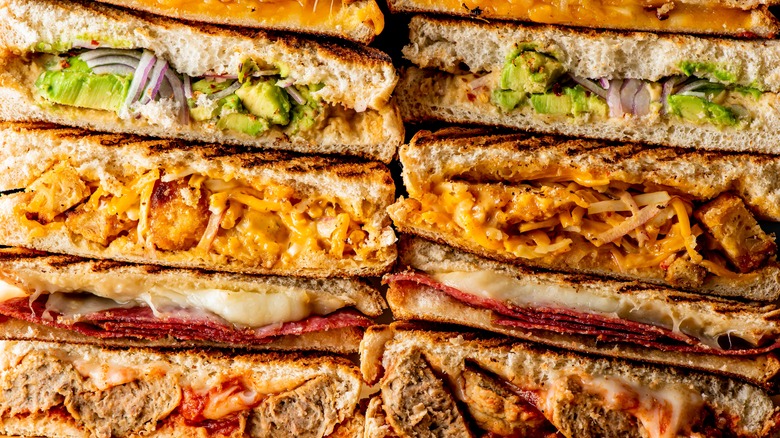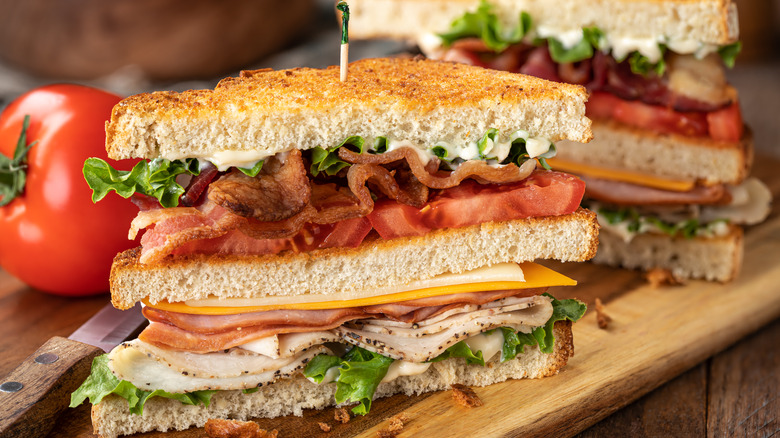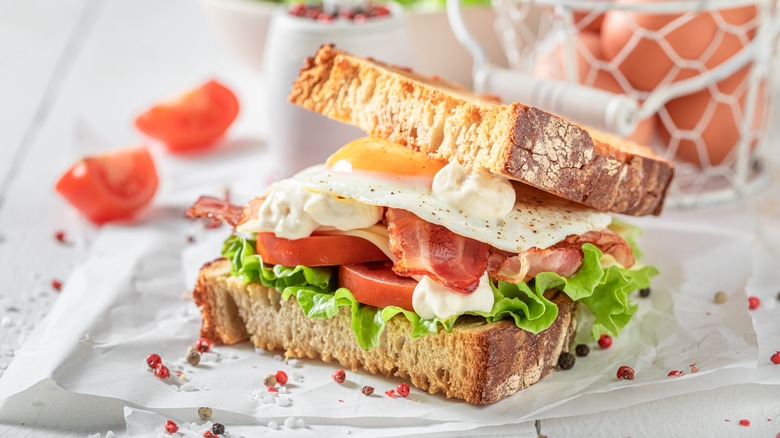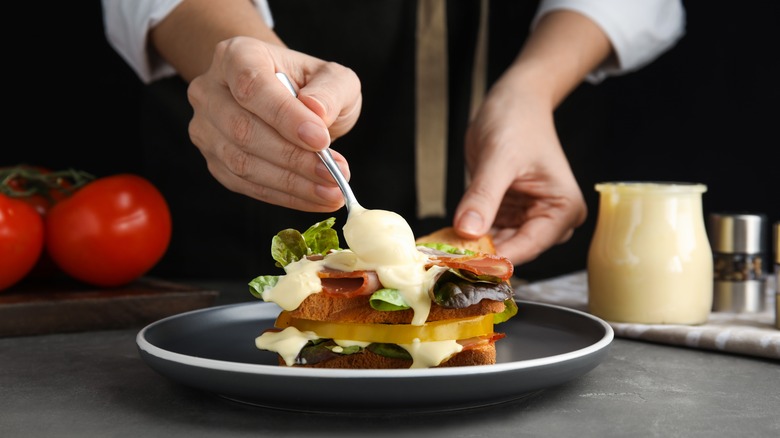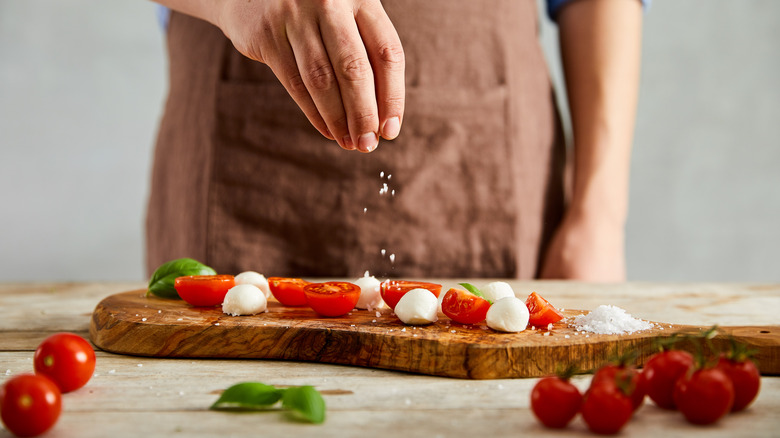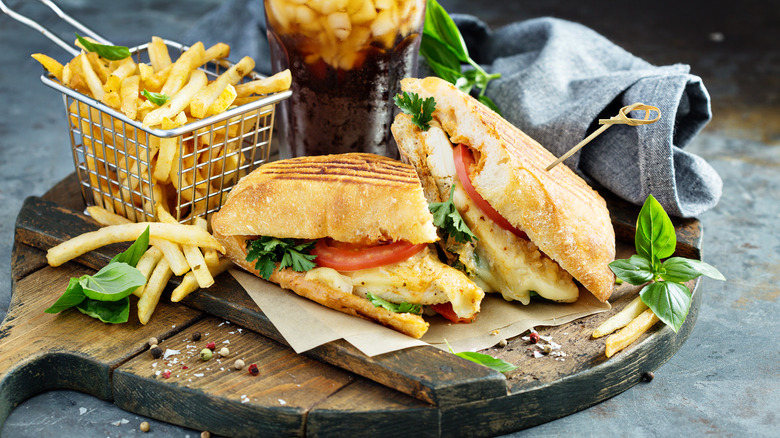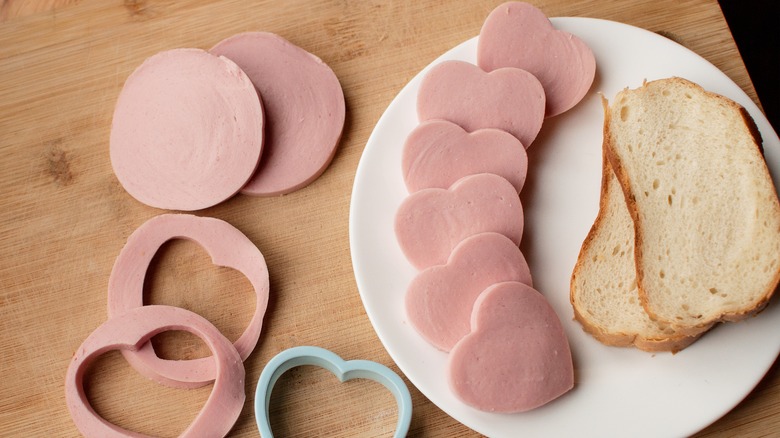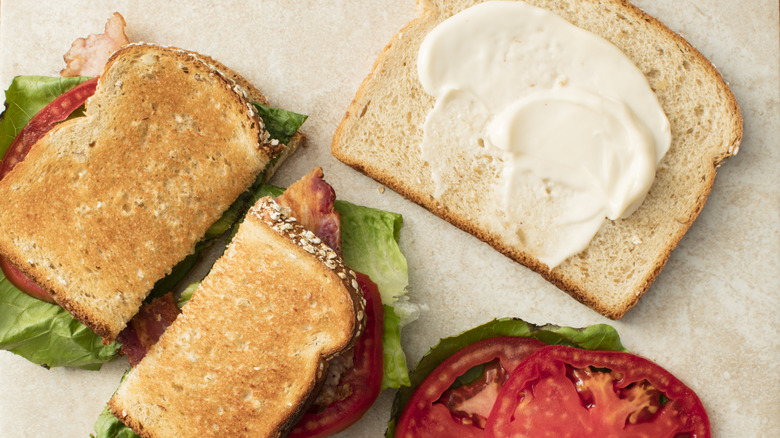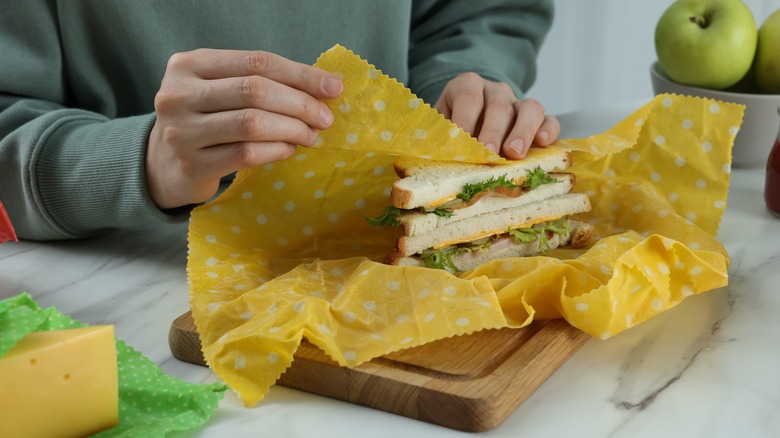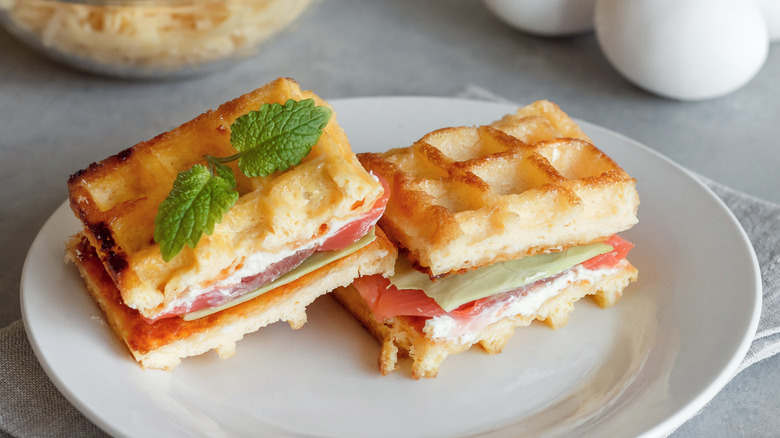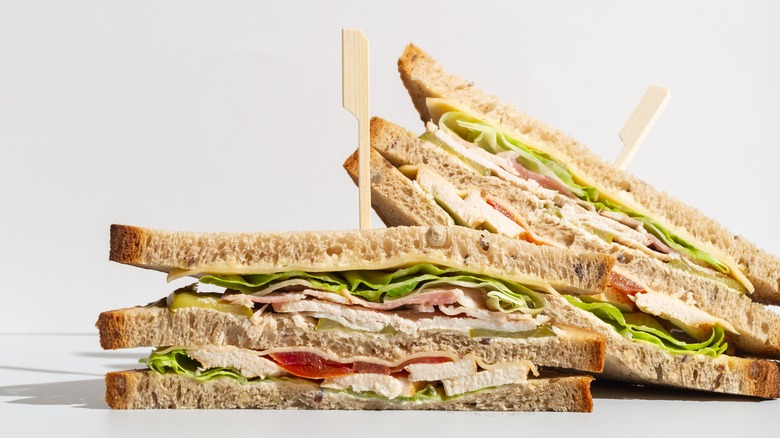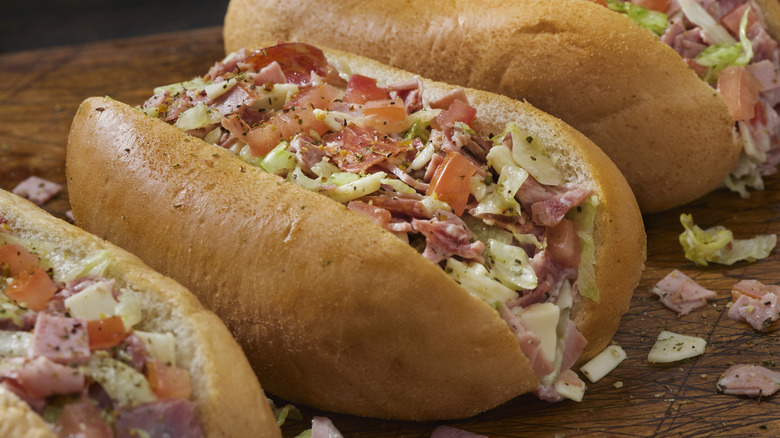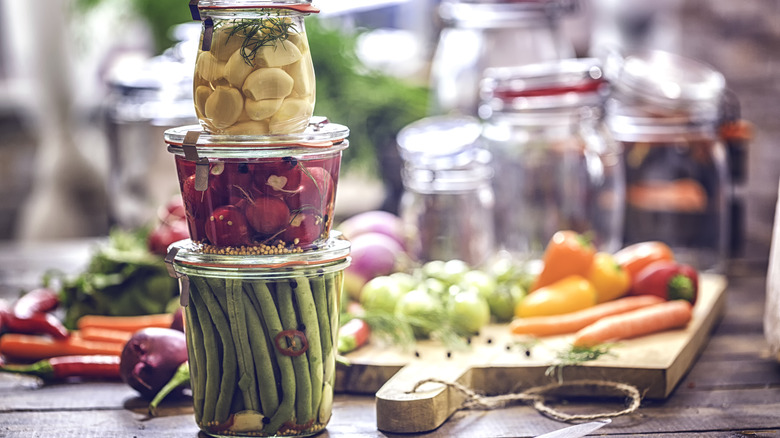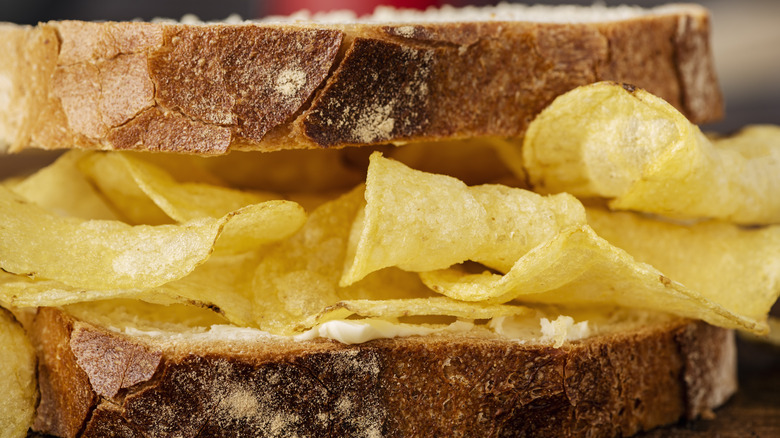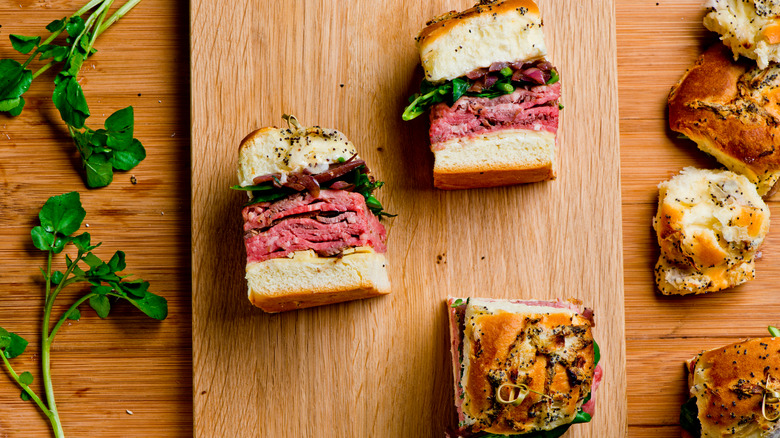14 Sandwich Making Hacks You Definitely Need To Know
The humble, dependable, versatile sandwich is one of those foods that can be life-alteringly delicious or a devastating disappointment. At its most basic level, a sandwich consists of fillings placed between layers of bread. Seems simple enough. And yet, delve into each step in the making of a sandwich and you will find a hundred ways it can go wrong.
The bread element is crucial, and there are so many factors to consider: texture, size, and density, to name a few. Then there are the fillings to ponder, which can consist of proteins like meats, seafood, and tofu, cheese, vegetables both raw and cooked. Flavors and textures must be well-balanced. And, holding it together are condiments and spreads, which help build the architecture of the sandwich while also adding moisture and flavor. Then there's the question of cooking: to toast or not to toast? Some sandwiches are ideal when the whole thing is pressed and heated, bit some sing best when left cool and fresh.
Knowing how to craft a great sandwich is a skill well worth learning. A few quick and easy tips to follow can truly elevate your sandwich game. Check out these sandwich-making hacks and the next time you throw a few ingredients between some bread, you'll be able to make the most of it.
1. Engineer your ingredients strategically
No matter how many or how few ingredients you include in your sandwich, you'll need to think carefully about how they're layered. The fillings go inside the bread, of course. But, configuring the order in which they're put together can mean the difference between a successful sandwich and a sloppy, soggy, slippery mess.
Keep in mind each ingredient's weight and texture. If you put the heaviest items at the top, they'll weigh down the rest of the sandwich and may make it more difficult to hold. Using the heavy, dense ingredients as a base gives the sandwich a satisfying gravitas, and keeps lighter ingredients from getting smushed and sliding out of the bread.
Speaking of sliding, make sure moist or slippery ingredients are separated by items with more grip. For example, you don't want juicy tomatoes and briny pickles layered together — put some greens, shredded meats, or dry and crunchy ingredients in between them to create stabilizing friction. If your sandwich consists of multiple slippery layers, consider layering an extra piece of bread in the middle to add more sturdiness.
2. Weave a tapestry of textures
A sandwich is only as good as its flavor, certainly, but mouthfeel is just as important. A sandwich that's too soft all the way through can come across like baby food. On the other hand, if every element from bread to filling is crunchy, it can leave your mouth torn up and tired. Achieving the right balance of textures takes a sandwich from unpleasant or mediocre to exceptionally satisfying. All you have to do is think each layer through.
If you're starting with bread, consider its texture. Is it soft and springy, like ciabatta? Or is it substantial and structured, like toasted sourdough? Try to complement and contrast the bread's texture with the fillings to get the most interesting combination of sensations in each bite. Super soft fillings, like a creamy egg salad, work nicely with a crunchy, toothsome bread. Fried chicken and crispy bacon on a soft and supple brioche bun create a delightful dichotomy. Once the bread and the main filling are sorted, the rest of the ingredients can be added to bring more textures into the mix.
Spreads can be silky like mayonnaise, grainy like certain mustards, or chunky like relishes and chutneys. It's nice to have a juicy element to bite into, such as a fresh tomato, and a fresh crisp vegetable like cucumber, celery, or red onion. Contrasting textures make each bite more satisfying.
3. Upgrade your condiments
Without spreads and condiments, a sandwich is just a dry pile of stuff — unpleasant to bite into, hard to chew, and an altogether sad state of affairs. So, why not make sure those all-important sandwich elements are the best they can be? There are a lot of excellent mayos, mustards, ketchups, and other traditional sandwich condiments on the market, so it doesn't have to take any extra work. But, if you want ultimate control and customization, you can always make your own versions, add unique flavors, or mix them up to create your own special sauce.
Homemade mayonnaise is surprisingly simple to make from scratch. Mixing ground spices or chopped fresh herbs into your sandwich spreads can be a total game-changer when it comes to flavor. And, don't limit yourself to the traditional options. Miso paste and tahini are delicious umami bombs and can be used alone or mixed with other condiments to add dimension. Go for a sweet and spicy chutney as an alternative to more common pickle relish. Spreadable cheeses like pimento cheese and pub cheese can do double duty on your sandwich, adding cheesiness as well as moisture in every bite.
4. Season everything individually
As with any dish, proper and thorough seasoning is key to maximizing taste. That means making sure that every bite is boosted with salt to bring out its full flavor. Since a sandwich is composed of many different layers of ingredients, it's critical to hit each piece with the right amount of salt before you get to the assembly phase. Otherwise, some elements may fall flat, and your sandwich will come across as dull and one-dimensional.
Certain processed ingredients, such as cheeses and cured meats, likely already contain the right amount of seasoning and may not need any further enhancement. But other items, especially fresh and raw vegetables, are best with a little boost. If you've got particularly juicy veggies, like tomatoes, salting allows them to release moisture and become more flavorful and concentrated, which will help to avoid a soggy, watery sandwich. A little bit of salt and pepper adds character to mild-tasting ingredients, such as lettuce and sliced cucumber.
When making a salad sandwich — like chicken, tuna, or this classic egg salad — always taste the filling to make sure it's got enough seasoning. If you're feeling adventurous, you can make your own sandwich seasoning blend by mixing ground herbs and spices of your choosing with salt to add even more complex flavor.
5. Combine hot and cold elements at the last second
Temperature is a crucial factor when it comes to sandwich success. While there are exclusively hot sandwiches like grilled cheese and cold sandwiches like Italian subs, many sandwiches lie somewhere in between, with some heated ingredients and others that should be kept cool. The key when making these hot-cold hybrid sandwiches is to keep the ingredients as far apart as possible until just before it's time to chow down.
One of the most common examples of this situation is a sandwich that has a cooked filling, say roasted chicken breast and melted cheese, but you also want to add crisp vegetables like lettuce, tomatoes, and perhaps some fresh green herbs like basil or dill. Those ingredients won't be as palatable once they're warmed and wilted. So keep those fresh-from-the-garden items cool, and once the rest of the sandwich is ready to go, throw everything together and enjoy. If you want to keep the hot and cool sides truly separated, you can add a piece of bread in between them to act as a temperature barrier.
6. Shape your ingredients to match
The perfect sandwich should be a pleasant eating experience from the first bite to the last. One of the flaws that can ruin this goal is a lack of consistency. If you've got a few bites that are nothing but bread and condiments, or some that contain too much cheese and others where it's missing completely, then your sandwich will only bring you disappointment.
To best ensure your fillings and bread are equally distributed in each bite, every element of the sandwich should be sliced, chopped, or folded to match one another. When layered together, you should be able to count each strata of the sandwich from any angle. If you can't get the ingredients to match up along the ends, use a cookie cutter or a pizza slicer to cut off the uneven bits and create a uniform size and shape. You'll be left with a perfectly shaped sandwich that's consistently layered all the way through.
7. Use moisture wisely
Arguably, the two worst sins you can commit in the making of a sandwich lie at the opposite ends of the moisture spectrum. A sandwich that's too dry is a crackly, dusty cluster of ingredients. On the other hand, no one wants a greasy or waterlogged swamp of a sandwich, either. Walking the tightrope between these two extremes can be easy with a few simple tips.
How you utilize moisture in your sandwich greatly depends on style and timing. A sandwich that's being packed up for a long road trip or picnic should be treated differently than one that's going to be eaten right away. Fatty spreads like butter and mayo can act as a moisture barrier when spread on bread, keeping water from getting into the bread's crumb and making it soggy. But eventually, if the sandwich sits for a long time, those fatty spreads can cause their own sogginess. In these cases, be creative with your condiments — you can pack them on the side, or place them in between other ingredients so they don't come in direct contact with the bread.
Some sandwiches are meant to sit and moisten for a while in order to give them their signature texture and character. New Orleans' famous Muffuletta, for example, is best when the oil and vinegar from the giardiniera soak into the bread. Know what type of sandwich you're going for, and your timeline for eating it, and apply condiments and sauces accordingly.
8. Swaddle your sandwich with a good wrap
Not all sandwiches need to be wrapped in paper — you can't wrap an open-faced melt, for example. But, even if you're making a simple sandwich to be eaten immediately in the comfort of your own home, a good swaddling after it's assembled can make a big difference. Paper can help keep ingredients from slipping out, save your hands from mess and your clothes from stains, and a little bit of pressure from a good wrap lets the sandwich ingredients meld together just a little bit better.
Wrapping your sandwich is doubly important if you're taking it elsewhere, as it needs to be protected on its journey. Parchment or waxed paper is a much better option than plastic wrap or bags, as paper is porous enough to let the sandwich breathe so the moisture isn't trapped like it is in plastic, leading to the dreaded soggy bread. But, it's still a solid enough barrier that it keeps the sandwich fresh and guarded from the elements.
9. Get creative with bread
Traditional types of sandwich bread, like sliced white, wheat, rye, or rolls, are classic for a reason. But, should you desire to venture off the beaten bread path, you can catapult your sandwich into a whole new dimension. There are endless alternatives to bread out there that can serve the same purpose while bringing new flavors and textures.
If you've ever tried to lower your carb intake, you've likely had to get creative with sandwiches. Not every sandwich needs a starchy exterior, it turns out. A jumbo pickle cut in two can hold fillings together just as well as bread, as can thick slices of firm vegetables like cucumber or jícama. Large mushroom caps are a great veggie alternative to round sandwich buns. And of course, a large leaf lettuce like romaine makes an excellent wrap.
For the bread fans that just want to mix things up, there are plenty of creative choices that keep things carb-heavy. Turn your hoagie roll into garlic bread before sandwich assembly — this works especially well with meatball subs. Bagels make great bases for sandwiches, but why not try a donut instead? Its sweetness contrasts beautifully with savory breakfast sandwich ingredients like sausage, bacon, and eggs. The nooks and crannies in waffles are perfect pockets for saucy and creamy sandwich fillings, both sweet and savory, like in this maple chicken waffle sandwich recipe.
10. Slim down bread that's too thick
Getting the width and density of your sandwich bread right is part art, part science. It takes a little bit of geometry and physics — you want it to match up properly with the height and weight of your fillings. But sometimes the perfect size of bread for a sandwich is counterintuitive, and of course, what's considered perfect can vary based on your own personal sandwich preferences.
Bread that's too thin and delicate is an obvious flaw, and one you'll likely notice right away as it won't be able to handle the sandwich's inner bounty. But bread that's too thick can be a problem, too. If your sandwich looks like it's going to be imbalanced, there are a few ways you can take care of it. If you're using sandwich rolls, dig a spoon down the center of the top half of the roll's interior surface, carving out a hollow space. This gets rid of excess bread and also creates a little pocket for more filling. If you're using slices, grab a rolling pin and gently flatten the slices down until they're the right height. Roll the bread super thin to make sliced pinwheel sandwiches.
11. Chop up and combine fillings for better bites
Sometimes a sandwich's ingredients can be too unwieldy, making it an annoying chore to eat. A bacon strip that's too thick to bite through can end up yanking out the rest of the filling, or a large leaf of iceberg can slide off the bread, taking everything else with it. There's an easy hack to rectify this dire situation — it takes a little bit of extra elbow grease, but once you've done it, you may never go back to basic layered sandwiches again.
Instead of placing the ingredients on top of one another vertically, turn them all into one big combined filling. This trick may not work for every sandwich — there are some ingredients you probably don't want to hack to bits, like a sunny-side-up egg or a meatball. But, for most proteins, cheeses, and veggies, a quick and thorough chop and a toss with condiments lets all the ingredients commingle and allows them to fill the bread better. Not to mention, you'll get more consistency in each bite, as the ingredients are evenly distributed.
12. Play with pickles
Is a sandwich even a sandwich without pickles? The pop of zippy flavor you get from a pickled ingredient takes a sandwich from blandness to brightness. If you find your sandwiches are lacking acidity, salt, or crisp texture, throw in some pickles and you'll solve all of these problems at once. Plus, you won't be adding many extra calories as juicy flavor bombs like a dill pickle, for example, carry around 4 calories.
While pickled cucumbers in chip or spear form are the most common sandwich additions, the world of pickles is vast and varied and worth experimenting with. Pickled jalapenos or other spicy peppers can add a bite of heat, pickled radishes are great for bright color and snappy texture, and pickled onions and garlic bring intense piquancy. If you can't decide, chop up a variety of pickled vegetables to make a relish, and you can really ramp up your sandwich's vibrancy.
13. Embrace unusual ingredients
Thinking outside of the box is a great way to upgrade your sandwiches. Classic filling combinations can be hard to beat — there's a reason B.L.T.s and P.B. and J.s are known to people everywhere by their abbreviations. But, experimenting with unconventional ingredients can open up a whole new world of texture and flavor between the bread. Anything you find in your pantry or fridge is fair game.
Crisp lettuce is often used for crunch, but try a layer of potato or tortilla chips instead for a salty crackle. Seeds and nuts are another textural option that's often overlooked. Just because you've already got carbs in the form of bread, doesn't mean you can't add more to the filling. Try topping your chosen protein with a layer of mac and cheese or crispy fried noodles. And, don't be afraid to mix sweet with savory, in the vein of peanut butter and jelly — cheeses and cured meats are nicely complemented by fresh fruit, jams and jellies, and honey.
14. Make multiple sandwiches out of one big loaf
If you're making sandwiches for a large group, or just want to save time by making several at once to save for later, forego the sliced sandwich breads and individual rolls. Instead, grab one large loaf of bread. Whole French or Italian loaves, baguettes, and large rectangles of focaccia or ciabatta can all be used to make multiple sandwiches.
Slice the loaf carefully down the middle and add your condiments and other fillings. Replace the top half, and then use a serrated knife to carefully cut the loaf into individual sandwich sizes. You can use this technique to make small finger sandwiches for cocktail parties, or larger standard-sized sandwiches for picnics or trips to the beach. This simple hack saves time and effort compared to having to craft each sandwich individually, and you'll end up with more consistent sandwiches this way, too.
